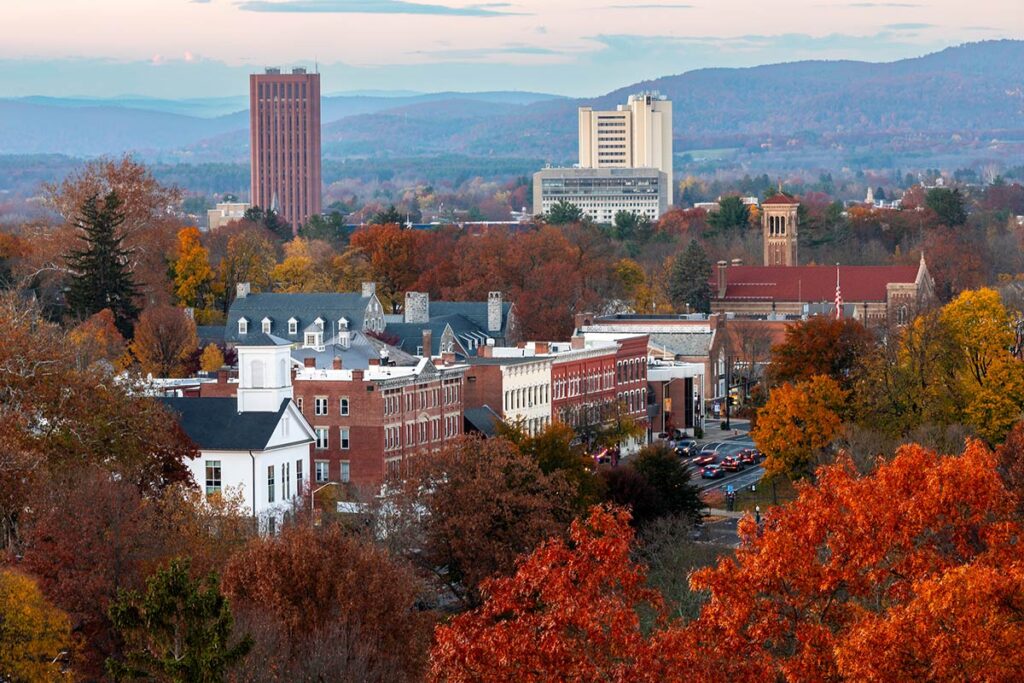Opinion: Amherst at a Crossroads: Housing, Parking, and Leadership

Photo: amherst.edu

Amherst’s challenges are not abstract but visible every day in overflowing driveways, pothole-ridden streets, hollowed-out storefronts, and families leaving for neighboring towns. With 39,000 residents and a shrinking year-round population, we face a housing crisis that cannot be solved with cautious half-measures.
UMass Amherst is both our lifeblood and our burden. It generates $2.9 billion in statewide economic impact, but it also places outsized strain on Amherst’s roads, neighborhoods, and services. Permanent residents are right to demand accountability: UMass must house more students on its land and contribute more fairly to town infrastructure.
Yet accountability doesn’t stop at UMass. Town leadership has been too timid. Over-occupancy, illegal parking, and absentee landlords persist despite stronger bylaws. Housing density proposals get stalled in endless “design guideline” debates. Council incumbents call themselves protectors of neighborhoods, but their caution is costing us families, schools, and a stronger tax base.
This November, voters will decide whether Amherst doubles down on delay or chooses bold leadership. That means leaders willing to streamline development, expand housing options including ADUs and RG density enforce bylaws fairly, and invest in infrastructure.
Parking and housing aren’t just logistics. They reveal who Amherst is and who Amherst is for. The status quo is not working. The next election will decide whether Amherst clings to caution or acts boldly to secure its future.
Rizwana Khan is a resident of Amherst and a member of the town’s Human Rights Commission.

I admire Ms Khan’s succinct statement. I would modify the headline only by suggesting – as the author does – that leadership is not one of the problems – it is THE problem. The maladies that Ms. Khan alludes to are all the result of specific policies that the Town’s leadership has advocated. I hope questions at the League’s candidate forums will be as specific and pointed as this commentary.
I’m confused by Ms. Khan’s comments on density. In the RG zoning district 7 units per acre is allowed, plus an extra ADU (or granny flat) under state law. Well before the recent state law change requiring ADUs in all towns, Amherst has had its own ADU bylaw allowing ADUs in all residential zoning districts. I don’t know of any town in Massachusetts that allows so much density in residential districts. Amherst Town Meeting and Town Council both have increased heights and density downtown and recently University Drive. Trouble is, almost everything that gets built goes to expensive student rentals-an apparently limitless demand or until 9000 more units are built. Not so many working people or families who can or want to pay $2400 for a 350 sq foot apartment. UMASS needs to step up and house many more if its students before Amherst becomes UMASSville.
I am confused by the “Hollowed-out” storefronts comment? Where are these exactly? Downtown has one empty space (that is not leased or being built out) recently vacated by a business who was able to purchase a location and own instead of lease. Other than that in our downtown what storefront is “hollowed out”, empty or even underutilized? The former Amhesrt cinema studio is under agreement, the space under 11 East Pleasant is in design? The former Himalayan Friends is now beautifully redesigned as The Closet, and just the other day a retailer asked me to keep my eyes open as they are looking to grow and need more space. So while I agree w the pot holes this statement that seems to be echoed often by a few other blog writers for the Indy always leaves me perplexed as to when the last time you walked through the downtown.
Gabrielle Gould thank you for your comment and for noting some of the new and transitioning businesses downtown. You’re right. Amherst Center is not full of boarded-up storefronts, and several recent changes (such as The Closet and the cinema space under agreement) are positive steps. That said, the description of downtown as “hollowed-out” is less about boarded-up windows and more about vibrancy, stability, and diversity of use. Vacancies exist: Listings like 57 E Pleasant (a 3,000 sq. ft. retail space) are actively marketed for lease, and several other commercial spaces remain in transition.
Short operating hours: Many businesses open only part of the day or close early, which leaves blocks of downtown quiet when they could be animated.
Staffing gaps: Shops and restaurants often run on skeleton crews or part-time staff, limiting consistency and reducing customer experience.
Thin consumer activity: Even when doors are open, foot traffic and sales are limited. Residents and visitors often comment that they browse but rarely buy, leaving businesses vulnerable to turnover.
These patterns add up to a downtown that feels less resilient and “hollowed-out” even when storefronts are technically occupied. Amherst needs more than occupied square footage — it needs sustainable, year-round businesses that draw and keep customers. My point is not to dismiss the progress you cite, but to highlight that a healthy downtown is measured by more than a headcount of active leases. It is about hours, staffing, vitality, and economic circulation and that is where the gap remains.
1) For year round residents and a healthy, vibrant, and growing population I would strongly advocate to focus on enabling more home ownership. Certainly there is also a place for rentals, but i am not sure how that can ever be separated from the student market. Cultivating and preserving the history and homes of Amherst should be a primary focus. To be clear, single family homes/condos (SFH) should be available and accessible for purchase by families, NOT captured and converted for rentals.
2) Residential property purchase and/or conversion for student rentals IS a viable business that can scale to meet small (single unit ADUs) or large investments (ex. Barry Roberts/G. Gould). So while there are many larger entities/businesses that buy and rent single family homes, I also assume that many residents in the area own rentals. My observation on this: when you can start to purchase additional properties for rent, the appreciation of the home increases its value, your costs are covered + profit, and you can leverage that equity to purchase more homes. it’s a rich-get-richer situation. There are two beautiful colonial homes across the street from me (rentals) that went up for sale. at >800,000$… these were hardly affordable to average resident. i spoke with a tentative buyer, local ER Dr. who wanted novel ways to invest his money with a rental property purchase… Likely sound financial situation for the individual, but another loss by a potential home-buyer/resident. So, how to disrupt that kind of cycle?
3) House values and housing market is absolutely locally inflated however legislation or community movements to increase pressure against SFH-rentals or otherwise will depress all local home values. Tread lightly if you proceed, many residents may not enjoy falling home prices.
4) More local tax pressure only worsens affordability problems and increases resident costs. My understanding is that the college and universities within Amherst are not under the same tax obligations as the residents. The tax in my view is a sort-of back-handed way to tax the institutions. the problem with that is it assumes your resident base are all employed by the universities. I can tell you the downtown shops and store are not employed by them… Decouple local taxes from “university taxes”.
5) the financial contrasts to surrounding communities is very large. house prices, taxes, etc. the bubble hurts Amherst residents.
END: approach the problem form both sides. Supply and Demand. More student housing on campus. More STUDENT housing off campus. Advocate for financial pressures that penalize SFH-rentals and alleviate SFH-residents. Actively work/incentivize Rental->SFH back-conversions. Redistribute tax burdens with the assumption that not all Amherst residents work for university. Foster new businesses and business ventures that are decoupled from the university. If long-term goals is long-term residents, enable for a professionally diverse, year-round work force.
UMass, and the Town for that matter, employ many smart people who recognize that they are better off living in one of the surrounding communities where taxes are lower, family housing is available, local government isn’t driven by a development-at-any-cost mentality, and the public has a voice in municipal affairs.